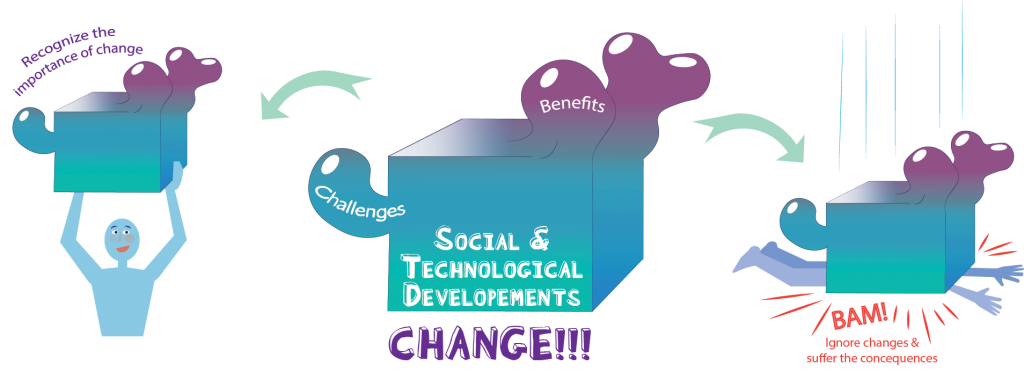
“To improve is to change. To be perfect is to change often.”
Winston Churchill
Rapid social and technologic developments in the world brought many benefits and emerging challenges to the people. Same goes to the companies or civil society organization on whom is to use those benefits and try to solve problems societies are facing. Those developments demand changes. However, it’s up to you to choose whether you will:
-
Recognize importance to change something within work of your organization and act accordingly
-
Ignore or neglect changes and wait to hit you like a bus.
Well, it’s often better to anticipate and adopt changes then to change as a case of emergency.
Being flexible and prepared for change gives your organization something which in business is called “a competitive leverage”. This means that you will much better and faster react to demands from your final beneficiaries and target group or provide an answer to challenges they are facing.

For example, Internet brought many benefits to the society. However, it also brought many challenges to the organizations. Internally we can talk about the way of interaction with the beneficiaries and target group or externally challenges such are transition on peer violence from face to face into virtual world. In both cases if you didn’t prepare yourself for these changes you could end up wasting time and resources in reaching your target group, or in the second scenario neglect highly important dimension of peer violence, putting that way success of methodology of yours into question.
In case you decide to change something in the work of your organization, and you are not sure how to put that through to the end. Don’t worry, as we summarized most important steps you need to have in mind in that process.
We develop step by step process, relying on the John Kotter change management process and adjusting it to fit
✔ First step is to identify the change. Discuss this with people from your team about
✔ Create a team of people for carrying on the change. Gather them and decide among you roles and responsibilities each person in that team will have. Before doing so, introduce them a to change management steps you need to do so they have a clear picture of this process in their minds;
✔ Describe a change so it become understandable and inspiring to the people in your organization;
✔ Create a vision of the change. Make it clear, concise and inspiring. It need to be understandable and compelling to all affected by the change (internally / externally). You could use same methodology here like the one we proposed for defining vision of your organization in the strategic planning part.
✔ Create a change road path. Define, steps objectives, indicators and deadlines. Assign each step of this process to certain people within your team.
✔ Present a change to the people within your organization. List in detail all people to be addressed by the change, methodologies of communicating change, organize a feedback sessions where people can reflect their worries and fears, etc
✔ Organize presentations of the short-term wins and successes. This way you will boost people motivation and make sure they don’t become overwhelmed with the process.
✔ Define procedures how you will monitor process and manage obstacles. You should define methodology, findings, recommendations and people in charge for adopting changes due to obstacles;
✔ Define analysis to be used to track change implementation and reflect on indicators.
